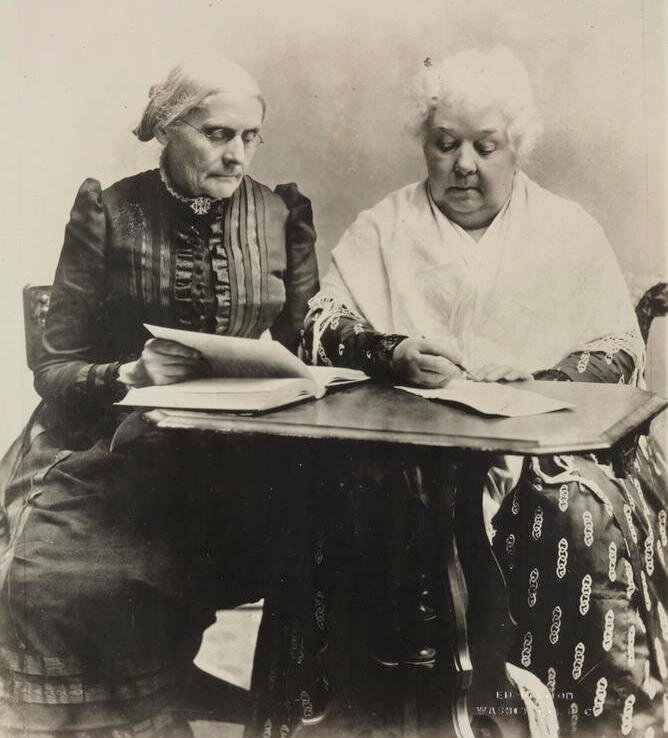“…we are not working for ourselves, but for those now suffering around us. For them, our sisters, and for future generations must we labor.”
The Hotel Balmoral on Mount McGregor.
Numerous famous and influential individuals made their way to the resort on Mt. McGregor in the late 1800s. In early August of 1889 famous suffragist Susan B. Anthony stayed at the Hotel Balmoral with her 24-year-old niece Maude. Anthony had dedicated her entire life to the advancement of women and this brought her into the sphere of Ulysses Grant and his wife Julia.
Susan B. Anthony in her 20’s.
Anthony, born in 1820, grew up in Battenville, NY less than 20 miles from Mt. McGregor and had taught and lectured in the area for years. Her childhood home which still exists in Battenville has recently been slated for preservation efforts. Her early life included religious tensions and financial struggles that once forced her family to move to a place called Hardscrabble. Coincidentally, Ulysses Grant when he was struggling to provide for his family before the Civil War had also lived for a short time at a place he called Hardscrabble. Both figures would emerge from their early struggles to become prominent figures in their time.
It would be in nearby Saratoga Springs, NY that Anthony on numerous occasions would attend and speak at women’s rights conventions including the summer of 1869 when 100 women’s rights delegates formed the New York Woman Suffrage Association. The following year there was a great feeling that success was within reach as influential women began supporting the cause. Anthony wrote with excitement at this time about the support of influential women including the First Lady Julia.
“Congress were here and large numbers of the aristocratic women of Washington… President Grant’s sister, Mrs. [Mary] Cramer, has been here and given her name, saying that Mrs. [Julia] Grant sent her regards and sympathized with our movement… The daily press is on its knees and is publishing long editorials in our favor.”
Julia Grant
U.S. v. Susan B. Anthony, Indictment for Illegal Voting (National Archives at New York City)
With the Republican platform being the first to mention the advancement of women, Anthony personally met with President Grant in 1872 to advocate for women’s suffrage. Although unable to achieve women’s suffrage directly, Grant oversaw the unprecedented appointment of thousands of women as Postmasters which included Anna M. Dumas the first African-American woman known to hold the position. Grant signed legislation expanding property and legal rights for women in Washington D.C. as well as wage rights for female federal workers. In response to a petition that he advocate for women’s rights in his second inaugural address, President Grant stated it had already been written but “looked with favor and approval on all efforts for the enlargement of woman's sphere of work and of influence."
Susan B. Anthony defied the law by voting for Grant in the 1872 election, was arrested and a sympathetic President Grant pardoned individuals involved in the incident. In ensuing decades many dedicated suffragists braved abuse, imprisonment, and even torture in their attempts to secure women’s rights. Their willingness to suffer showcased their deep commitment and belief in the righteousness of their cause.
Grant at Mt. McGregor 1885 (Courtesy of Marina Amaral)
As General Grant soldiered on with his book project while suffering from throat cancer in the summer of 1885, Anthony and Elizabeth Cady Stanton were hard at work on their own literary project, the History of Woman Suffrage. They were all trying to look back and record the struggles they had taken pivotal roles in. After a lifetime of commitment to their causes, they sought to produce an honest account for the benefit of their readers. Though Grant’s book sold well, Anthony’s was not deemed profitable forcing her to purchase and publish the work herself. The History of Woman Suffrage eventually recorded the entire legacy of the movement spanning 41 years from 1881 to 1922 encompassing 5700 pages in 6 volumes. Upon hearing of Grant’s death while traveling by train through Illinois Anthony noted in her diary: “The weather is lovely and springlike today, but how still and solemn it seems out here on these broad prairies with that great general gone forever!"
Anthony & Stanton working on the History of Woman Suffrage.
On her visit to Mt. McGregor in 1889, Anthony took the time to tour the nearby Cottage that a few years before had housed the man she once met as President. Perhaps it was the lack of a good guide or the nature of the building being kept as a resort attraction, but the rights pioneer had a decidedly negative reaction to what she encountered: “Here we saw the room where General Grant died, the invalid chair, the clothes he wore, medicine bottles, etc.—very repulsive. If the grand mementoes of his life's work were on exhibition it would be inspiring, but these ghastly reminders of his disease and death are too horrible." Of course many would say that the Cottage represents a shining triumph in Grant’s life’s work as he fulfilled his final act of devoted duty to his loving family. It is a surprise that someone like Anthony, who had persevered in the face of adversity failed to see the merit in preserving a place that represented the power of dedication in the face of suffering. Grant, averse to displays in his honor, would almost certainly have agreed with the suffragist in not seeing the true purpose in a memorial to him on Mt. McGregor. Whether they would have approved or not, others have chosen to memorialize and remember them and many have been inspired in these places.
General Grant’s room at Drexel Cottage.
Susan B. Anthony & fellow suffragists in 1896.
In 1890 the suffrage movement unified and became more powerful under the leadership of Anthony. In 1896 and 1898 the National American Woman’s Suffrage Association held conferences in Washington DC. Conference attendees were invited to a reception celebrating the 70th birthday of Julia Grant in 1896 and again in 1898 for the 78th birthday celebration for Anthony. At both events, Julia Grant was introduced to hundreds of suffragists. Anthony would pass away in the winter of 1906 after a 60+ year struggle to obtain the vote for women. Like Grant, her life was dedicated to others, to the betterment of generations she would never meet. In August 1920 the dream of women’s suffrage in the U.S. Constitution became a reality with the ratification of the 19th Amendment. The long journey of suffering and sacrifice could finally claim victory. Now 100 years later museums and memorials continue to highlight one brave man and one brave woman who were willing to endure suffering in order to help shape a better future for those around them.
Women casting their first vote in 1920.
Sources:
The Papers of Ulysses S. Grant
The Life and Work of Susan B. Anthony by Ida H. Harper 1898
The General’s Wife by Ishbel Ross 1959
The Evening Star, January 27, 1896
St. Louis Democrat, March 3, 1873














